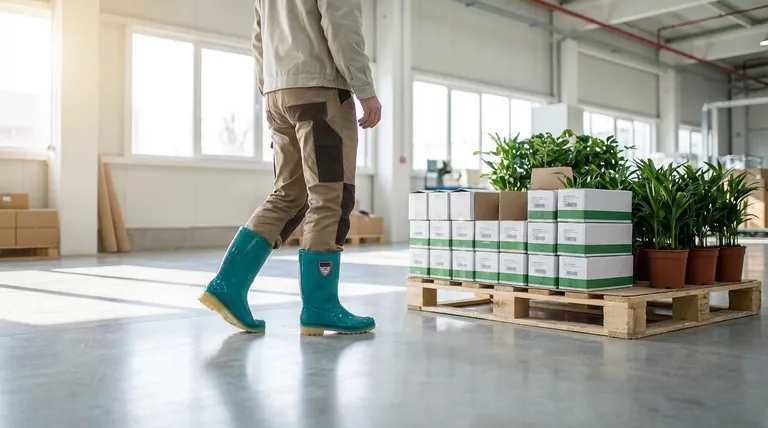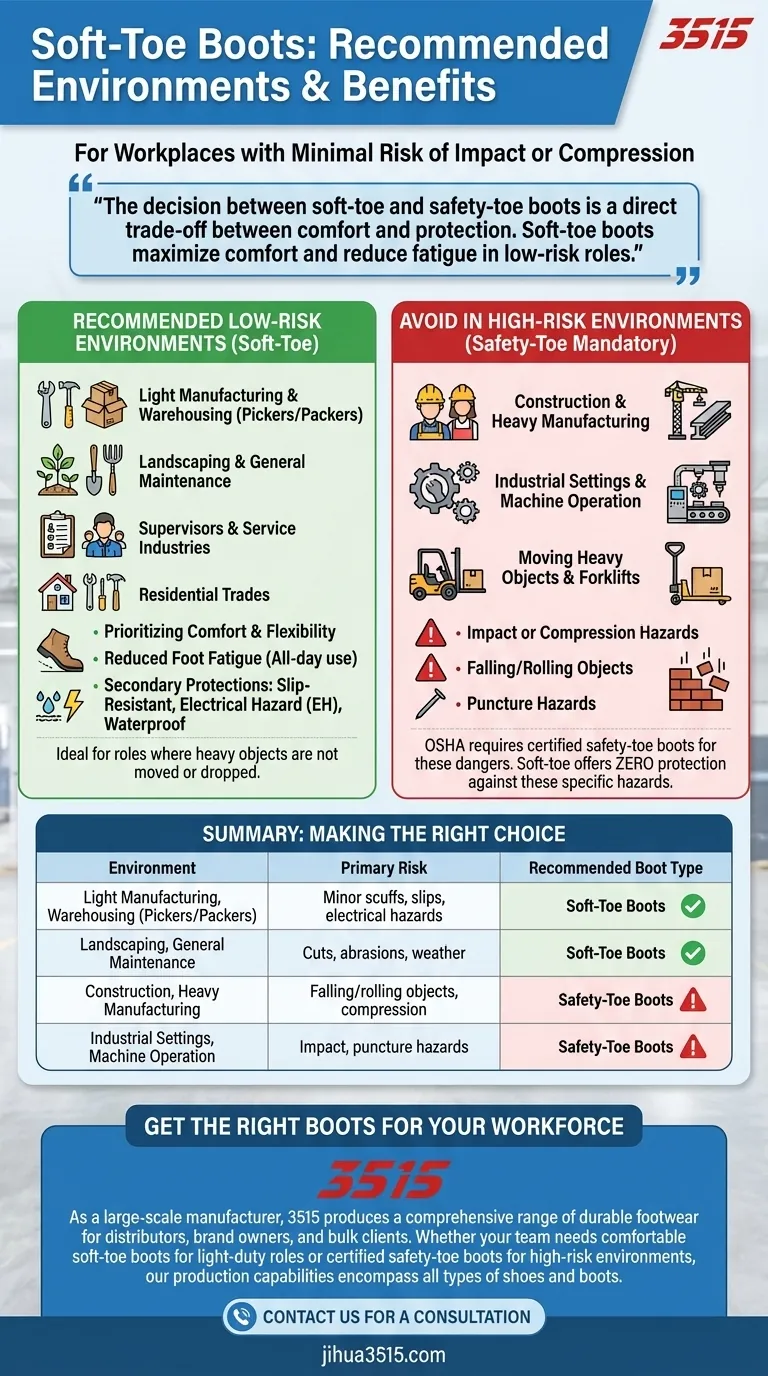In short, soft-toe boots are recommended for work environments with minimal risk of foot injuries from impact or compression. They are the ideal choice for jobs where heavy objects are not being moved or dropped, and where the primary needs are comfort, flexibility, and protection from minor scuffs, liquids, or electrical hazards.
The decision between soft-toe and safety-toe boots is a direct trade-off between comfort and protection. Soft-toe boots maximize comfort and reduce fatigue in low-risk roles, while safety-toe boots are a non-negotiable requirement for environments with impact or crushing hazards.

The Role of Soft-Toe Boots in the Workplace
Most people think of heavy-duty steel toes when they hear "work boots," but the reality is that many jobs don't require that level of protection. Soft-toe boots fill a critical role by providing durability and support without the extra weight and rigidity of a safety toe cap.
Prioritizing Comfort and Flexibility
The primary advantage of a soft-toe boot is comfort. By omitting the rigid toe cap (made of steel, aluminum, or composite material), the boot is lighter and more flexible.
This leads to reduced foot fatigue over long shifts, making them a superior choice for workers who are constantly on their feet but not exposed to heavy hazards.
Environments Suited for Soft-Toe Boots
Soft-toe boots excel in professions where the risk of a heavy object falling on your foot is extremely low.
Think of roles in light manufacturing, warehousing (for pickers and packers, not forklift operators), landscaping, general maintenance, and certain residential trades where heavy materials are not the norm. They are also common in service industries and for supervisors who walk job sites but are not directly involved in hazardous tasks.
When Protection Still Matters
Even without a safety toe, these boots offer crucial protection. They feature durable leather or synthetic uppers to guard against scrapes, and many include slip-resistant outsoles to prevent falls on wet or oily surfaces.
Some soft-toe models also offer secondary protections like waterproofing or electrical hazard (EH) ratings, which are vital in certain conditions.
Understanding the Critical Trade-offs
Choosing the wrong type of footwear is not just a matter of comfort; it's a significant safety decision. Misunderstanding the limitations of soft-toe boots can lead to serious injury.
The Non-Negotiable Need for Safety Toes
If your work environment involves construction, heavy manufacturing, industrial settings, or operating heavy machinery, a safety-toe boot is mandatory.
The Occupational Safety and Health Administration (OSHA) requires protective footwear in any workplace where there is a danger of foot injuries due to falling or rolling objects. A soft-toe boot offers zero protection against these specific hazards.
The Myth of "One Boot Fits All"
No single boot is perfect for every job. A boot designed for a warehouse worker prioritizes cushioning and low weight, while a boot for a welder prioritizes heat-resistant materials and heavy-duty protection.
Attempting to use a soft-toe boot in a high-risk environment to gain a little extra comfort is a dangerous gamble that violates safety protocols.
Assessing Your Actual Risk
The most important step is to honestly evaluate your daily tasks. Do you handle heavy parts? Do you work around forklifts or pallet jacks? Could tools or materials fall from a height?
If the answer to any of these questions is yes, your choice has already been made for you: you need a certified safety-toe boot.
Making the Right Choice for Your Job
Your final decision should be guided by a clear understanding of your job's daily demands and safety requirements, not just by comfort alone.
- If your primary focus is all-day comfort in a low-risk setting: A soft-toe boot is the superior choice for reducing fatigue in roles like light assembly, general maintenance, or landscaping.
- If your job involves any risk of impact or compression: You must choose a certified safety-toe boot (steel, composite, or alloy) to meet safety standards and prevent serious injury.
Ultimately, the right boot is the one that provides the appropriate level of protection for the real risks you face every day.
Summary Table:
| Environment | Primary Risk | Recommended Boot Type |
|---|---|---|
| Light Manufacturing, Warehousing (Pickers/Packers) | Minor scuffs, slips, electrical hazards | Soft-Toe Boots |
| Landscaping, General Maintenance | Cuts, abrasions, weather | Soft-Toe Boots |
| Construction, Heavy Manufacturing | Falling/rolling objects, compression | Safety-Toe Boots (Mandatory) |
| Industrial Settings, Machine Operation | Impact, puncture hazards | Safety-Toe Boots (Mandatory) |
Get the Right Boots for Your Workforce
As a large-scale manufacturer, 3515 produces a comprehensive range of durable footwear for distributors, brand owners, and bulk clients. Whether your team needs comfortable soft-toe boots for light-duty roles or certified safety-toe boots for high-risk environments, our production capabilities encompass all types of shoes and boots to meet your exact specifications and safety standards.
Let us help you equip your team with the perfect balance of comfort and protection.
Contact our team today for a consultation to discuss your bulk footwear needs.
Visual Guide

Related Products
- Factory Direct Wholesale Rain Boots Durable Waterproof & Fully Customizable
- Premium KPU Injection Athletic Style Safety Shoes
- Premium High-Cut Waterproof Safety Boots Manufacturing & Wholesale Solutions
- Durable Goodyear Welt Leather Work Boots for Wholesale & Private Label
- High Performance Fire-Retardant Waterproof Safety Boots
People Also Ask
- What are the key characteristics of rain boots? Essential Features for Total Dryness
- What factors should be considered when choosing rain boots? Find the Perfect Boot for Your Needs
- What are rain boots made of? Discover the best materials for ultimate waterproof protection.
- What are the liner materials for rain boots? Cotton vs. Blends for Comfort & Durability
- What are the limitations of rain boots in certain climates? Find the Right Footwear for Your Weather



















